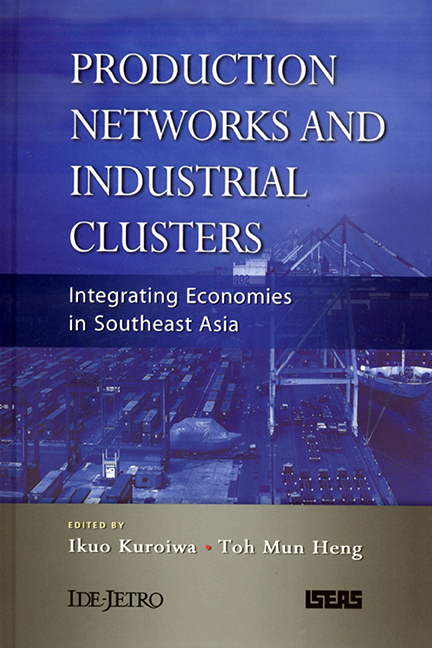Book contents
- Frontmatter
- Contents
- List of Tables
- List of Figures
- Preface
- Acknowledgements
- Contributors
- 1 Introduction
- I Overview of the Production Networks and Industrial Clusters in Southeast Asia
- 2 The Mechanics of Production Networks in Southeast Asia: The Fragmentation Theory Approach
- 3 Cross-Border Production Networks in Southeast Asia: Application of the International Input-Output Analysis
- 4 Industrial Clusters and Production Networks in Southeast Asia: Global Production Network Approach
- II Case Studies
- III Drivers for the Expanding Production Networks
- Index
2 - The Mechanics of Production Networks in Southeast Asia: The Fragmentation Theory Approach
from I - Overview of the Production Networks and Industrial Clusters in Southeast Asia
Published online by Cambridge University Press: 21 October 2015
- Frontmatter
- Contents
- List of Tables
- List of Figures
- Preface
- Acknowledgements
- Contributors
- 1 Introduction
- I Overview of the Production Networks and Industrial Clusters in Southeast Asia
- 2 The Mechanics of Production Networks in Southeast Asia: The Fragmentation Theory Approach
- 3 Cross-Border Production Networks in Southeast Asia: Application of the International Input-Output Analysis
- 4 Industrial Clusters and Production Networks in Southeast Asia: Global Production Network Approach
- II Case Studies
- III Drivers for the Expanding Production Networks
- Index
Summary
WHAT HAPPENS IN INTERNATI ONAL TRADE AND INDUSTRIAL LOCATI ON?
At this point in time, Southeast Asia is truly an unique area in that it gets involved deeply with sophisticated international production networks extended to the whole East Asia. The formation of international production networks in East Asia has created an unprecedented pattern of trade and industrial location across countries with different income levels and development stages. In the process of forming production networks, the perception of hosting foreign direct investment (FDI) has totally been renewed, and strategies for industrial promotion have also been critically reviewed. It is now extremely important to analyse the nature and characteristics of international production networks in East Asia and discuss their policy implication for less developed countries (LDCs) such as some Southeast Asian countries. This chapter provides an overview on the current status of economic analysis on this issue, placing its emphasis on the newly developed fragmentation theory approach.
Until the 1980s, Southeast Asian countries followed a typical North- South trade pattern; they exported natural-resource-based products and labour-intensive manufactured goods to developed countries while importing a whole range of capital-intensive/human-capital-intensive manufactured goods. Trade with neighbouring countries at similar income level was basically inactive. Such a trade pattern was well explained by the traditional trade theory based on comparative advantage such as the Ricardian and Heckscher-Ohlin models in which international trade occurred due to differences in technologies and/or factor endowments among countries. A major portion of FDI was in import-substitutingtype industries with highly distortive trade protection and a long list of performance requirements, and export-oriented FDI was confined to export-processing zones from which the domestic economy was cautiously insulated.
Trade and FDI patterns in Southeast Asia have drastically changed since the beginning of the 1990s. The North-South trade pattern has steadily subsided, and massive intra-industry trade, particularly in general and electric machineries, has gradually dominated trade in East Asia. The intraindustry trade is actually vertical, in contrast with horizontal intra-industry trade in Europe. The vertical product differentiation model, however, does not seem to explain a large portion of East Asia's intra-industry trade. Rather, we observe the explosive development of dense transactions in parts and components among East Asian countries accompanied with production-process-wise division of labour.3 Export-oriented or networkforming- type FDI has occupied the center stage, replacing for importsubstituting- type FDI.
- Type
- Chapter
- Information
- Production Networks and Industrial ClustersIntegrating Economies in Southeast Asia, pp. 33 - 53Publisher: ISEAS–Yusof Ishak InstitutePrint publication year: 2008



